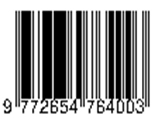Etiologi, Distribusi Lokasi, dan Terapi Ulser Traumatik pada Pasien di Rumah Sakit Gigi dan Mulut Universitas Padjadjaran
Abstract
Introduction: Oral mucosal ulceration can be caused by local or systemic factors. One of the local factors often expressed by patients is the result of being bitten. Research data on oral mucosal ulceration has not been widely published, especially in Indonesia, so the purpose of this study was to provide information on the etiology, site distribution and therapy of traumatic ulcers in patients at the Dental Hospital, Universitas Padjadjaran (RSGM Unpad). Methods: A descriptive study, with data obtained secondary from the medical records of patients at the RSGM. Data presentation is done by tabulation and percentage. Results: There were 44 patients consisting of 15 males (34.05%) and 29 females (65.95%), with an age range of 17 – 55 years. Trauma which is the most common cause of ulcers is due to accidentally biting, the most common site is the buccal mucosa, and the most widely used drug is a combination of vitamins and anti-inflammatory which was given to 10 patients with traumatic ulcers (22.7%). Conclusion: The most common cause of oral ulcers is trauma, and the most common trauma in adults is the result of accidentally biting.
Keywords
Full Text:
PDF (Bahasa Indonesia)References
Regezi JA, Sciubba JJ, Jordan RCK. Oral Pathology: Clinical Pathologic Correlations. 2017. 387 p.
Tosun MK and T. Oral Mucosal Trauma and Injuries. In: Intech. 2019. p. 18.
Anura A. Traumatic Oral Mucosal Lesions: A Mini Review and Clinical Update. OHDM. 2014;13(2):254–9.
Michael Glick. Burket’s Oral Medicine. 12th ed. Connecticut: People’s Medical Publishing House; 2015. 683 p.
Chen JY, Wang WC, Chen YK, Lin LM. A retrospective study of trauma-associated oral and maxillofacial lesions in a population from southern Taiwan. J Appl Oral Sci. 2010;18(1):5–9.
Mortazavi H, Safi Y, Baharvand M, Rahmani S. Diagnostic Features of Common Oral Ulcerative Lesions: An Updated Decision Tree. Int J Dent. 2016;2016.
Talacko A, Gordon A, Aldred M. The patient with recurrent oral ulceration. Aust Dent J. 2010;55:14–22.
Sally Hannoodee; Dian N. Nasuruddin. Acute Inflammatory Response - StatPearls - NCBI Bookshelf. 2020. p. 1–4.
Puspitasari D, Apriasari ML. Analysis of traumatic ulcer healing time under the treatment of the Mauli banana ( Musa acuminata ) 25 % stem extract gel. :21–5.
Zakiawati D, Nur’aeny N, Setiadhi R. Distribution of oral ulceration cases in Oral Medicine Integrated Installation of Universitas Padjadjaran Dental Hospital. Padjadjaran J Dent. 2020;32(3):237.
Balan U, Gonsalves N, Jose M, Girish KL. Symptomatic Changes of Oral Mucosa during Normal Hormonal Turnover in Healthy Young Menstruating Women. :178–81.
Gilvetti C, Porter SR, Fedele S. Traumatic chemical oral ulceration : a case report and review of the literature. Nat Publ Gr [Internet]. 2010;208(7):297–300. Available from: http://dx.doi.org/10.1038/sj.bdj.2010.295
Fourie J, Boy S. Oral mucosal ulceration - a clinician’s guide to diagnosis and treatment. South African Dent J. 2016;71(10):500–8.
Shane B. Folate and vitamin B12, metabolism: Overview and interaction with riboflavin, vitamin B6, and polymorphisms. Food Nutr Bull. 2008;29(2 SUPPL.).
Kumar M, Chawla R, Goyal M. Topical anesthesia. 2015;31(4).
DOI: https://doi.org/10.33854/jbd.v8i3.1022
DOI (PDF (Bahasa Indonesia)): https://doi.org/10.33854/jbd.v8i3.1022.g395
Refbacks
- There are currently no refbacks.
Copyright (c) 2021 B-Dent: Jurnal Kedokteran Gigi Universitas Baiturrahmah

This work is licensed under a Creative Commons Attribution-NonCommercial-ShareAlike 4.0 International License.




